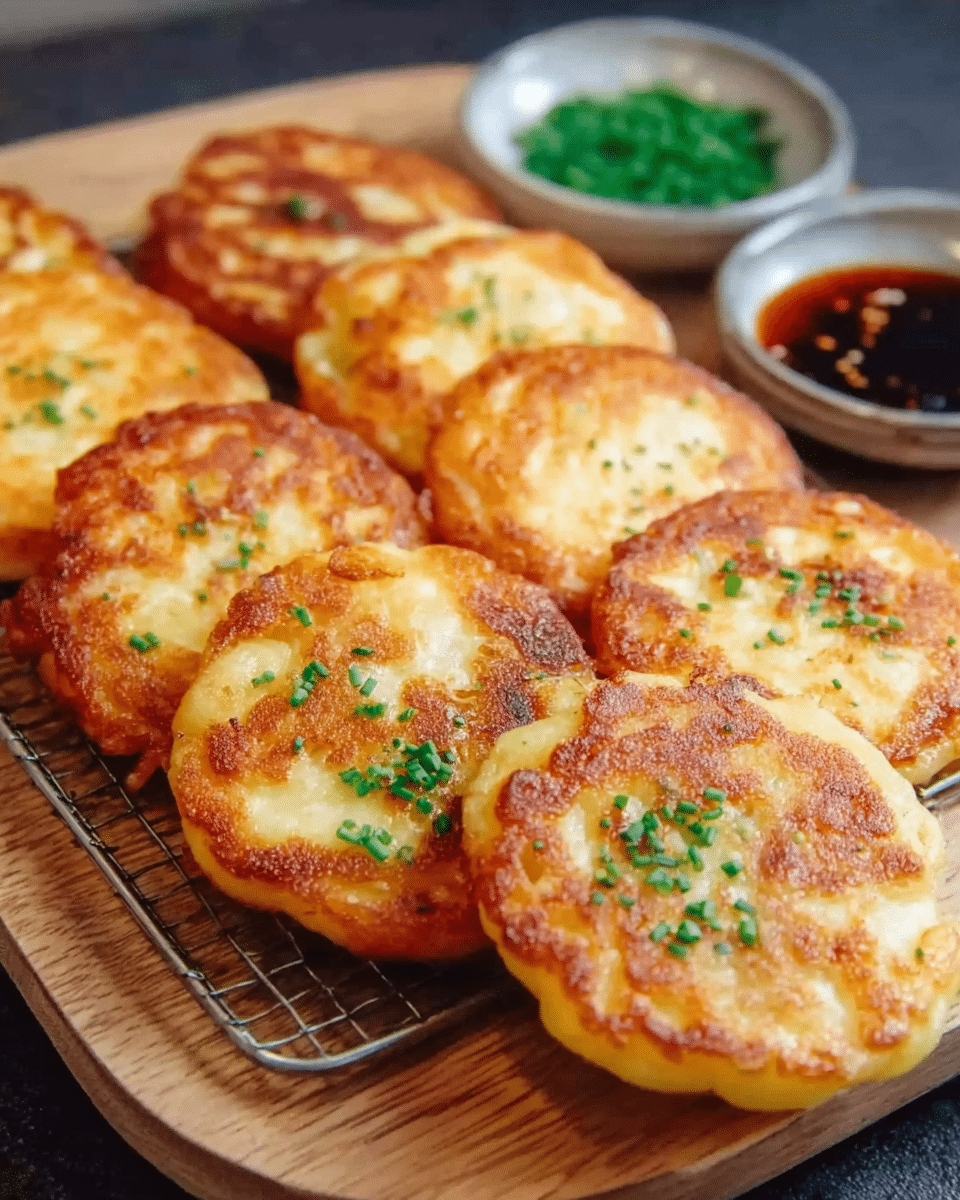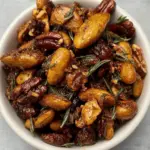Gamjajeon is a delicious Korean dish that blends the comforting taste of potatoes with the gooey richness of melted cheese. These savory pancakes are golden brown on the outside, crispy, and filled with cheese in the center. They are perfect for a snack or a side dish and pair wonderfully with a dipping sauce for added flavor.
Full Recipe:
Ingredients
-
3 medium-sized potatoes, grated
-
1/4 cup cornstarch
-
Salt, to taste
-
Black pepper, to taste
-
2 green onions, chopped (save some for garnish)
-
1/2 cup grated cheese (cheddar or mozzarella work well)
-
Oil for frying
Directions
-
In a large bowl, combine the grated potatoes, cornstarch, salt, pepper, and chopped green onions (save a little for garnish).
-
Mix thoroughly until the ingredients are well combined.
-
Add the grated cheese into the mixture. If you prefer a cheesy center, you can form small balls of the potato mixture and place the cheese in the center.
-
Heat a non-stick pan over medium heat and add a drizzle of oil.
-
Scoop spoonfuls of the potato mixture onto the pan, pressing them into round pancake shapes.
-
Cook for about 3-4 minutes on each side or until golden brown and crispy.
-
While the pancakes are still on the pan, sprinkle more grated cheese on top and let it melt for a minute or two.
-
Transfer the pancakes to a serving plate, garnish with the reserved green onions, and serve warm.
Nutrients
(For one serving, approximate values may vary depending on specific ingredients and portions)
-
Calories: 180 kcal
-
Carbohydrates: 28g
-
Protein: 5g
-
Fat: 7g
-
Fiber: 3g
The Origins of Gamjajeon
Gamjajeon holds a special place in Korean cuisine and is often enjoyed during family gatherings, special occasions, or as a street food snack. The term “Gamja” refers to potatoes, while “Jeon” is a word used in Korean to describe pancakes or fritters. Though potatoes are not native to Korea, they have been incorporated into many traditional Korean dishes over the years. The concept of making savory pancakes from vegetables is common in Korean cuisine, with variations made using ingredients like kimchi, seafood, or vegetables. However, Gamjajeon has gained significant attention due to its straightforward preparation and the appealing contrast of textures and flavors.
The dish is typically made by grating fresh potatoes and mixing them with a binding agent, often cornstarch or flour, to create a cohesive batter. The addition of cheese takes the dish to the next level, turning it into an irresistible treat. The savory pancakes are shallow-fried until they achieve a crispy exterior, and the cheese melts into the center, making each bite a delightful combination of crispy and gooey.
The Flavor Profile of Gamjajeon
What makes Gamjajeon stand out is its unique flavor combination. The potatoes provide a neutral, earthy base that is perfectly complemented by the saltiness of the cheese. Whether you opt for mozzarella, cheddar, or a combination of both, the cheese melts beautifully into the pancake, creating pockets of rich, gooey goodness. The addition of green onions lends a mild, savory depth to the dish, enhancing its overall flavor.
The pancake’s crispy texture on the outside gives way to a soft, fluffy interior that holds together thanks to the binding of cornstarch. This combination of textures—crispy on the outside, soft and cheesy on the inside—makes each bite a satisfying experience. The salt and pepper bring out the natural flavors of the potatoes while providing a subtle kick. A dipping sauce, often made with soy sauce, vinegar, or gochujang (Korean chili paste), can further enhance the flavor, adding an additional layer of depth.
Cooking Techniques and Tips
While the process of making Gamjajeon is relatively simple, a few techniques and tips can elevate the dish to perfection. First, using fresh, firm potatoes is essential. Russet or Yukon Gold potatoes are ideal as they have a starchy texture that helps bind the pancake mixture together. After grating the potatoes, it is crucial to remove any excess moisture. Potatoes tend to release a lot of water when grated, and too much moisture can make the pancakes soggy. You can do this by wrapping the grated potatoes in a clean kitchen towel and gently squeezing out the water.
Another important tip is the cooking method. To achieve that perfectly crispy exterior, it is essential to fry the pancakes in oil over medium heat. Cooking on too high a heat can cause the pancakes to brown too quickly on the outside while remaining raw on the inside. A non-stick pan is recommended to ensure that the pancakes don’t stick to the surface, making flipping easier and preventing any unnecessary mess.
If you’re aiming for an extra cheesy experience, you can experiment with different cheese combinations. Cheddar, mozzarella, and even a bit of Parmesan work wonderfully in Gamjajeon. For a more savory variation, consider adding a dash of garlic powder or chili flakes to the mixture.
The Role of Dipping Sauces
While Gamjajeon is flavorful on its own, pairing it with a dipping sauce can enhance the overall experience. A classic dipping sauce is made with a combination of soy sauce, vinegar, and a touch of sesame oil. This creates a balanced sauce that adds a tangy, salty contrast to the savory pancakes. If you enjoy a bit of heat, adding gochujang (Korean chili paste) or a pinch of red pepper flakes to the sauce can provide an exciting kick.
Alternatively, you can serve Gamjajeon with a creamy dipping sauce, such as a mixture of mayonnaise and sriracha. The creamy texture contrasts nicely with the crispy pancakes, providing a satisfying and indulgent combination of flavors. For a more traditional touch, you could also serve the dish with kimchi on the side, as the spicy and tangy fermented cabbage complements the mild flavors of the potato pancakes.
Gamjajeon as a Versatile Dish
Gamjajeon is a dish that can easily be adapted to suit various dietary preferences and occasions. While the traditional recipe features potatoes and cheese, you can make your own variations to suit your tastes. For example, adding finely chopped vegetables like carrots, zucchini, or bell peppers to the mixture can create a more colorful and flavorful dish. For a lighter version, you can experiment with using less cheese or opting for a non-dairy alternative.
In addition to being a delicious side dish, Gamjajeon can also be served as a main course. Pairing it with a side of salad or soup can create a well-rounded meal. If you’re hosting a gathering, Gamjajeon makes a great appetizer that will surely impress your guests. The crispy pancakes are bite-sized and easy to serve, making them perfect for a party or potluck.
Health Considerations
While Gamjajeon is a delicious and indulgent treat, it can also be part of a balanced diet when enjoyed in moderation. Potatoes are a good source of complex carbohydrates, providing energy and essential nutrients like potassium and vitamin C. The addition of cheese adds protein and calcium, while the green onions provide a boost of vitamins and minerals. However, due to the frying process, it is important to enjoy this dish in moderation to avoid excess calories and fat. To make the dish slightly lighter, you can opt to bake the pancakes instead of frying them or use a healthier oil, such as olive oil, for frying.
Conclusion
In conclusion, Gamjajeon is a delightful Korean dish that offers a perfect combination of crispy, golden-brown potatoes and gooey cheese. Whether you are enjoying it as a snack, side dish, or light meal, Gamjajeon brings comfort and flavor to the table. Its rich texture, savory taste, and versatility make it a crowd-pleaser for all occasions. With a few simple ingredients and basic cooking techniques, you can create this delicious dish that will surely satisfy your cravings. Don’t forget to serve it with a flavorful dipping sauce to enhance the taste further and make the experience even more memorable. Whether you’re a fan of traditional Korean cuisine or simply looking for a new way to enjoy potatoes, Gamjajeon is a dish worth trying.






